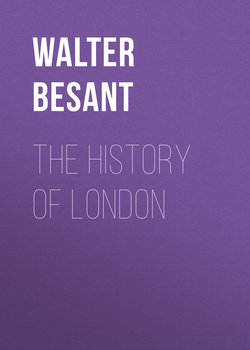Читать книгу The History of London - Walter Besant - Страница 2
2. THE FOUNDATION OF LONDON
ОглавлениеPART II
On these low hillocks marked on the map London was first founded. The site had many advantages: it was raised above the malarious marsh, it overlooked the river, which here was at its narrowest, it was protected by two other streams and by the steepness of the cliff, and it was over the little port formed by the fall of one stream into the river. Here, on the western hill, the Britons formed their first settlement; there were as yet no ships on the silent river where they fished; there was no ferry, no bridge, no communication with the outer world; the woods provided the first Londoners with game and skins; the river gave them fish; they lived in round huts formed of clay and branches with thatched roofs. If you desire to understand how the Britons fortified themselves, you may see an excellent example not very far from London. It is the place called St. George's Hill, near Weybridge. They wanted a hill – the steeper the side the better: they made it steeper by entrenching it; they sometimes surrounded it with a high earthwork and sometimes with a stockade: the great thing being to put the assailing force under the disadvantage of having to climb. The three river sides of the London fort presented a perpendicular cliff surmounted by a stockade, the other side, on which lay the forest, probably had an earthwork also surmounted by a stockade. There were no buildings and there was no trade; the people belonged to a tribe and had to go out and fight when war was carried on with another tribe.
The fort was called Llyn-din – the Lake Fort. When the Romans came they could not pronounce the word Llyn – Thlin in the British way – and called it Lon – hence their word Londinium. Presently adventurous merchants from Gaul pushed across to Dover, and sailed along the coast of Kent past Sandwich and through the open channel which then separated the island of Thanet from the main land, into the broad Thames, and, sailing up with the tide, dropped anchor off the fishing villages which lay along the river and began to trade. What did they offer? What Captain Cook offered the Polynesians: weapons, clothes, adornments. What did they take away? Skins and slaves at first; skins and slaves, and tin and iron, after the country became better known and its resources were understood. The taste for trading once acquired rapidly grows; it is a delightful thing to exchange what you do not want for what you do want, and it is so very easy to extend one's wants. So that when the Romans first saw London it was already a flourishing town with a great concourse of merchants.
How long a period elapsed between the foundation of London and the arrival of the Romans? How long between the foundation and the beginnings of trade? It is quite impossible even to guess. When Cæsar landed Gauls and Belgians were already here before him. As for the Britons themselves they were Celts, as were the Gauls and the Belgians, but of what is called the Brythonic branch, represented in speech by the Welsh, Breton and Cornish languages (the last is now extinct). There were also lingering among them the surviving families of an earlier and a conquered race, perhaps Basques or Finns. When the country was conquered by the Celts we do not know. Nor is there any record at all of the people they found here unless the caves, full of the bones which they gnawed and cut in two for the marrow, were the homes of these earlier occupants.
When the Romans came they found the town prosperous. That is all we know. What the town was like we do not know. It is, however, probable that the requirements of trade had already necessitated some form of embankment and some kind of quay; also, if trade were of long standing, some improvement in the huts, the manner of living, the wants, and the dress of the people would certainly have been introduced.
Such was the beginning of London. Let us repeat.
It was a small fortress defended on three sides by earthworks, by stockades, by a cliff or steeply sloping bank, and by streams; on the fourth side by an earthwork, stockade, and trench. The ground was slightly irregular, rising from 30 to 60 feet. An open moor full of quagmires and ponds also protected it on the north. On the east on the other side of the stream rose another low hill. The extent of this British fort of Llyn-din may be easily estimated. The distance from Walbrook to the Fleet is very nearly 900 yards; supposing the fort was 500 yards in depth from south to north we have an area of 450,000 square yards, i.e. about 100 acres was occupied by the first London, the Fortress on the Lake. What this town was like in its later days when the Romans found it; what buildings stood upon it; how the people lived, we know very little indeed. They went out to fight, we know so much; and if you visit Hampstead Heath you may look at a barrow on the top of a hill which probably contains the bones of those citizens of London who fell in the victory which they achieved over the citizens of Verulam when they fought it out in the valley below that hill.
